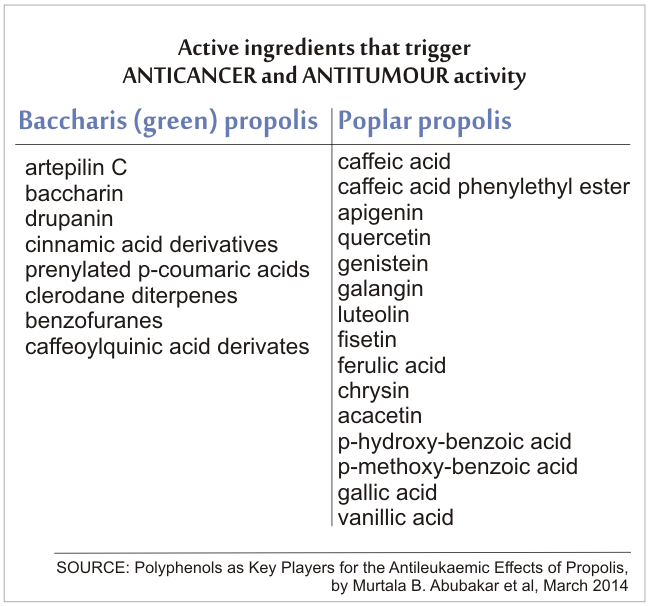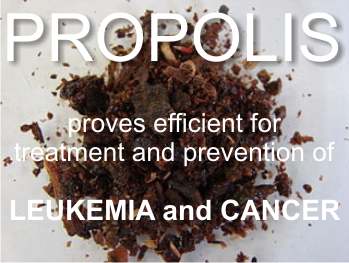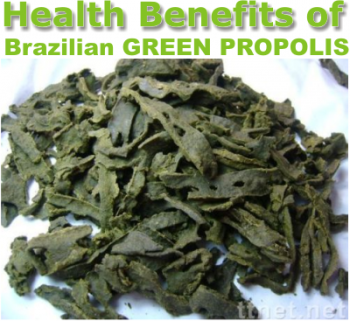Composition of propolis has always been studied, and according to a recent review by Kurek-Górecka et al, there are about 300 compounds that have been isolated from propolis. By now. The main constituents are phenolic acids, flavonoids, terpenes, lipid-wax substances, beeswax, bioelements, and many other constituents like vitamins, proteins, amino acids, and sugars. In terms of quantity and type, phenolic compounds (polyphenols) make up the most numerous group of compounds found in propolis.
Propolis is normally dark brown in color, but there are also green, red, black, and white hues. This happens because the plants that are harvested by bees are so different, and the composition of propolis will never be the same. It depends on season, weather, geographical region, even from hive to hive. Read here more on their geographical differences.
Composition of raw Poplar propolis
Balsams: originate from the collected glue from the poplars and are ethanol soluble, represent 40 – 70 % of all constituents, and are mainly:
- Phenolics: Phenols, phenolic acids, esters, flavanons, dihydroflavanons, flavons, flavonols, chalkones, phenolic glycerides;
- Aliphatics: acids, alcohols, esters, aldehydes, ketones, benzoic acid and esters.
Essential oils: have a poplar origin and are ethanol soluble, represent 3-5 % of all propolis contents and are Mono-, and sesquiterpenes.
Non-balsams: Substances which are added by the bees, which are ethanol insoluble and represent 20-35%. They are beeswax components.
Others: almost 5 % of all propolis. Partly ethanol soluble and come from bee and pollen origin.
- Mainly minerals
- average ash content 2.1 %
- Polysaccharides: 2 %
- Proteins, amino acids, amines and amides: 0. 7 %
- Traces of carbohydrates, lactones, quinones, steroids, vitamins
Because propolis is made of different trees, which are influenced by different geographical and meteorological conditions, the composition of propolis is very different even from hive to hive. For example, the Brazilian Green Propolis has a different composition.
• What is propolis
• Propolis can prevent and treat LEUKEMIA and CANCER
• Brazilian Green Propolis health benefits
Composition of raw Baccharis propolis
– The balsam substances are 45-60% of all contents and are mainly cinnamic acid and derivatives, coumaric acid, prenylated coumpounds, artepillin C; and some minor quantities of phenolics as flavonoids, benzoic acid, aliphatic acids and esters;
– The non-balsam sunbstances are 10-15 % of all constituents, have a Baccharis origin and are prenylated compounds, alkanes and terpenoids;
– Beeswax are present in a 15-25 %, higher that of the regular propolis;
– Other substances like 5% of all constituents, mainly:
- 2.5 – 4.5 % minerals
- 1-2 % of carbohydrates: fructose, mannose, inositol, erythrose
- 1-2 %: glycerol, lower aliphatic acids, amino acids, amines
The Evidence-Based Complementary and Alternative Medicine published in 2014 the study Polyphenols as Key Players for the Antileukaemic Effects of Propolis, by Murtala B. Abubakar et al, from the Universiti Sains Malaysia, reviewing the molecular bases of antileukaemic activity of both crude propolis and individual polyphenols on various leukaemia cell lines, and it indicates that propolis has the potential to be used in both treatment and prevention of leukaemia.
The studied propolises were the common poplar propolis, from Populus tremula resin, and the Brazilian green propolis, made from Baccharis dracunculifolia resin. We can see they have different constituents and yet both of them have anticancer and antitumor activity.
The review concludes that propolis and its phenolic contents have been shown to have antileukaemic activities which are achieved through a number of mechanisms that include induction of apoptosis and differentiation, cell cycle arrest, and inhibition of growth and proliferation in various types of leukemia cell lines. This suggests that propolis and its polyphenols components may be used as effective adjuncts to chemotherapy in the treatment of cancers.
From propolis from Kenya two new arylnaphtalene lignans were isolated, tetrahydrojusticidin B 1 and 6-methoxydiphyllin 2, along with four known phenolic compounds 5-8, found for the first time in propolis. The geranylstilbenes 7 and 8 demonstrated antibacterial activity against S. aureus, and the geranylflavon macarangin 6 possessed antiradical activity against DPPH radicals. (Petrova et al, 2010)
Due to its constituents propolis was always used as medicine, and today we have introduced it at a large scale in lots of medicines. But probably its major quality is that of antioxidant.
! Propolis is a very powerful antioxidant. The antioxidant effect of propolis is higher than that of Bee Pollen. Keep this is mind when searching for healing an oxidative damage related disease.
This effect is due to the high concentration of phenolics and other antioxidant compounds. Today it is considered that the active free radicals are involved in almost all the cellular degradation process and lead to cell death. Oxidative stress is thought to contribute to the development of chronic and degenerative diseases such as cancer, autoimmune disorders, aging, cataract, rheumatoid arthritis, cardiovascular and neurodegenerative diseases. As a powerful antioxidant, propolis can be regarded as a supplement preventing chronic degeneration diseases.
But besides the antioxidant effect, propolis is also antibacterial, antiviral, antifungal, antiulcer, against parazites, radiation protenctive, hepatoprotective, antitumor, antimutagenic, anti-angiogenic, cyto- and chemopreventive, antiinflammatory, immunostimulating, immunomodulating (immunosuppressive in autoimmune diseases), anti-diabetes, cardioprotective (antimyocard, antithrombogenic, antihypertensive, antiarhythmic), local anaesthetic, improves regeneration of cartilagenious and bone tissue, dental pulp, cicatrising, food preservative, anti-ostheoporose.
• How should we take propolis?
Quality requirements regarding harvest
It is very important how propolis is harvested.
Propolis can be harvested using many methods, and in 2010 a team of Italian researchers chemically characterised samples of propolis harvested with the following methods: by scraping, with plastic mats and with wooden wedges. The results showed that the propolis harvested with wooden wedges had the highest content of balsam, thus the best quality¹.
An Argentinian research paper recommends plastic mats as a better harvesting method than scraping, because it has lower Pb contamination ².
It is recommended to collect propolis from Spring to Autumn. Propolis that has been in the bee hive during winter
is much darker and is of lesser quality (Percie du Sert, personal communication).
Contamination:
Honey bees use propolis to seal the hive from their enemies and to protect it from various microorganisms that could infect them, especially during winter. Beekeepers use different substances to protect them even more, but this means that propolis can be easy contaminated with them.
The most important contaminants are heavy metals and lipophylic synthetic acaricides used for varroa mite control.
Yet, a minimal contamination can be guaranteed by using certified organic propolis. Look for them when you are buying it.
Is it considered a supplement by conventional medicine?
In most countries of the world, propolis use is not regulated.
In some countries, e.g. Austria, France, Spain, Japan, Taiwan, Korea, USA and Brasil propolis is considered as food supplement, together as the other bee products like bee pollen and royal jelly.
In others countries like Switzerland and Germany it is considered a medicine. (!) And so is in Asia.
We have to consider the natural variation and thus the varying properties of propolis, which makes its application in medicine problematic. Dr. Stefan Bogdanov advises people to consider it a food supplement with functional properties.
The health enhancing properties of propolis have much in common with the original function of propolis as a “defendant of the hive”. It is used to defend human health against microbes and to enhance human immunity against microbial intruders and disease.
|
|
References and picture sources:
¹ PAPOTTI, G; BERTELLI, D; PLESSI, M; ROSSI, M C (2010) Use of HR-NMR to classify propolis obtained
using different harvesting methods. International Journal of Food Science and Technology 45 (8): 1610-
1618.
² SALES, A; ALVAREZ, A; AREAL, M R; MALDONADO, L; MARCHISIO, P; RODRIGUEZ, M; BEDASCARRASBURE, E (2006) The effect of different propolis harvest methods on its lead contents determined by ET AAS and UV-visS. Journal of Hazardous Materials 137 (3): 1352-1356.
– Stefan Bogdanov, Bee Product Science, bee-hexagon.net, February 2014
– hindawi.com
“Forager honey bee with bags of propolis” picture credit Max Westby published under CC via flickr.com










Hello Laura, hope this finds you in best of health and spirits.
I am Khaled from Saudi Arabia. I am 38, got a stroke and carotid stenosis since October 2018 and a gallbladder stones before that by a year. I wanted to consult you if you are aware of any natural products that might improve my atherosclerosis condition.
Best regards
Hi Kladed,
Unfortunately things are not that easy. I am not qualified to give recommendations, this is an informative website only. I gather available information, from science and tradition, structure them and offer them to the public for an easier understanding.
All the best! L